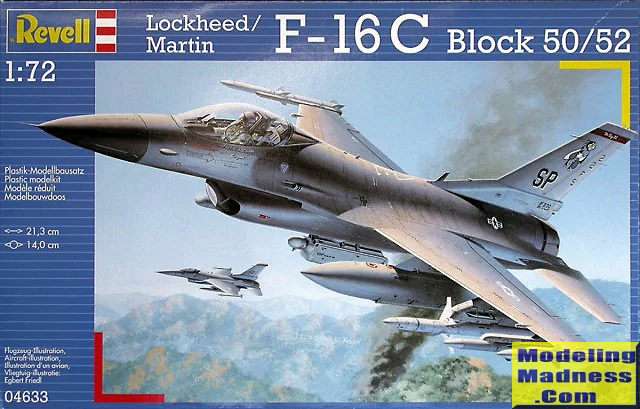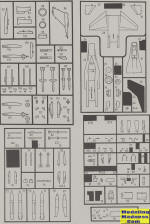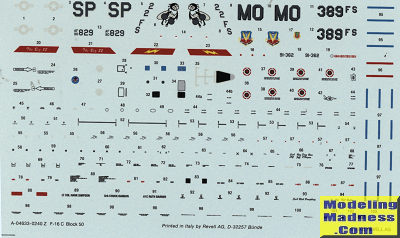
Revell 1/72 F-16C Block 50/52
| KIT #: | 04633 |
| PRICE: | $12.00 'used' |
| DECALS: | Two options |
| REVIEWER: | Scott Van Aken |
| NOTES: | 2002 boxing |

| HISTORY |
Block 50/52plus
This variant, which is also known as the Block 50/52+ has solely been developed for foreign sales with no USAF units flying the type. Its main differences are the addition of support for conformal fuel tanks (CFTs), a dorsal spine compartment, the APG-68(V9) radar, an On-Board Oxygen Generation (OBOGS) system and a JHMCS helmet.
The CFTs are mounted above the wing, on both sides of the fuselage and are easily removable. They provide an additional 440 US gallons or approximately 3,000 pounds (1,400 kg) of additional fuel, allowing increased range or time on station and frees up hardpoints for weapons instead of underwing fuel tanks. All two-seat "Plus" aircraft have the enlarged avionics dorsal spine compartment which is located behind the cockpit and extends to the tail. It adds 30 cu ft (850 L) to the airframe for more avionics with only small increases in weight and drag.
Poland took delivery of its first F-16C Block 52+ aircraft on 15 September 2006. The "Poland Peace Sky program" includes 36 F-16Cs and 12 F-16Ds. All 48 aircraft were delivered in 2008. The Hellenic Air Force took delivery of its first F-16C Block 52+ aircraft on 22 May 2008. The total Greek order is for 20 F-16Cs and 10 F-16Ds. The remaining 26 aircraft should be delivered by March 2010. The Israeli F-16I and its Singapore equivalent variant are based on the block 52+ aircraft. In March 2010 it was announced that the Egyptian Air Force would purchase 20 Block 52 aircraft (16 F-16Cs and 4 F-16Ds), the first of which arrived for testing in April 2012.
| THE KIT |
 Prior
to the release of the Tamiya F-16CJ in this scale, this was probably the best
1/72 F-16 produced. It went that extra step in detail from the Hasegawa Falcons
(which are still very nice kits). First boxings were for the F-16
MLU that was previewed here
several years ago. Careful examination of the sprues of that kit and this one
will show many similarities. What this one has done is go the extra step and
provide parts for the 'big mouth' versions of the Falcon.
Prior
to the release of the Tamiya F-16CJ in this scale, this was probably the best
1/72 F-16 produced. It went that extra step in detail from the Hasegawa Falcons
(which are still very nice kits). First boxings were for the F-16
MLU that was previewed here
several years ago. Careful examination of the sprues of that kit and this one
will show many similarities. What this one has done is go the extra step and
provide parts for the 'big mouth' versions of the Falcon.
It takes an F-16 aficionado to be able to spout of block numbers and such, but the biggest difference between the two is that looking at the front, the intake makes one look like it is 'smiling' while the other does not. This is due to the different engines in the 'big mouth' version. Later block aircraft also have bulged gear doors (which I didn't see in the kit) and some other differences that I can't tell without a guild book of some sort.
With all those options, this is a kit from which you can build a wide range of different F-16 versions. You can see from the parts scan that there are quite a few areas blacked out as not used in this boxing. Interestingly, this looks very much like the same kit as in the Monogram boxing many years back, including an identical box art save for different unit. You get a full range of weapons as well as a nicely detailed cockpit and bits that are not used in this boxing such as the shorter A tail and the very early stabs. You could probably build a pre-plus F-16A with what's here.
Instructions are standard RoG of the time on near newsprint quality
paper, but quite well done. Colors are given in Revell paint number and
some FS numbers as needed.
Two markings options are provided. One is the box art plane from the 52nd FW based at Spangdahlem at the time, a logical choice for a Revell of Germany kit. The other is for the 366 wing based at Mountain Home. Both aircraft are shown in the simplified two grey camouflage scheme. Decals are very nicely done and include quite a few stencils. You also get markings for all the weapons and the tanks.
| CONCLUSIONS |
Though this kit is near 20 years old, it is still a very nice one and because it can be found at a most reasonable price, is one that you may want to seek.
| REFERENCES |
https://en.wikipedia.org/wiki/General_Dynamics_F-16_Fighting_Falcon_variants
October 2018
Copyright ModelingMadness.com. All rights
reserved.
r If you would like your product reviewed fairly and fairly quickly, please
contact
the editor
or see other details in the
Note to
Contributors. Back to the Main Page
Back to the Review
Index Page
Back to the Previews Index Page